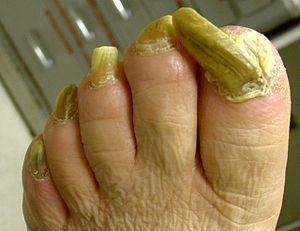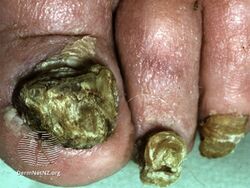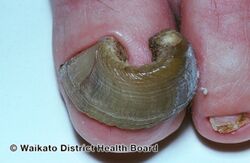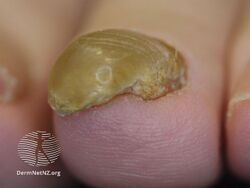Onychogryphosis
| Onychogryposis | |
|---|---|
| Other names: Onychogryposis or Ram's horn nails[1] | |
 | |
Onychogryphosis is a thickening that may produce nails resembling claws or a ram's horn.[2]
Trauma and pressure are typical causes.[3] The condition is more frequently seen in the elderly, in psoriasis, with fungal infection, and in peripheral vascular disease.[4]
Signs and symptoms
-
Onychogryphosis
-
Onychogryphosis
-
Onychogryphosis
-
Onychogryphosis
-
Onychogryphosis
Causes
Onychogryphosis may be caused by trauma or peripheral vascular disease, but most often secondary to self-neglect and failure to cut the nails for extended periods of time.[2][5] This condition is most commonly seen in the elderly.
Treatment
Some recommend avulsion of the nail plate with surgical destruction of the nail matrix with phenol or the carbon dioxide laser, if the blood supply is adequate.[2][6]: 659
Epidemiology
Severe congenital onychogryphosis affecting all twenty nailbeds has been recorded in two families who exhibit the dominant allele for a certain gene.[7][8] Congenital onychogryphosis of the fifth toe (the baby, little, pinky or small toe) is fairly common, but asymptomatic and seldom brought to the attention of medical professionals. Rather, it is brought to the attention of manicurists who routinely file the clawed toenail flat.
See also
References
- ↑ Tosti, A; Piraccini, BM (2008). "Chapter 70 – Nail Disorders". In Bolognia, JL; Jorizzo, JL; Rapini, RP (eds.). Dermatology. Vol. 1 (2nd ed.). St. Louis: Mosby Elsevier. ISBN 978-1-4160-2999-1.
- ↑ 2.0 2.1 2.2 James, William D.; Elston, Dirk; Treat, James R.; Rosenbach, Misha A.; Neuhaus, Isaac (2020). "33. Diseases of the skin appendages". Andrews' Diseases of the Skin: Clinical Dermatology (13th ed.). Edinburgh: Elsevier. p. 782. ISBN 978-0-323-54753-6. Archived from the original on 2023-06-30. Retrieved 2024-01-18.
- ↑ Johnstone, Ronald B. (2017). "2. Diagnostic clues and "need-to-know" items". Weedon's Skin Pathology Essentials (2nd ed.). Elsevier. p. 31. ISBN 978-0-7020-6830-0. Archived from the original on 2023-06-30. Retrieved 2024-01-18.
- ↑ Saavedra, Arturo; Roh, Ellen K.; Mikailov, Anar (2023). "32.Disorders of the nail apparatus". Fitzpatrick's Color Atlas and Synopsis of Clinical Dermatology (9th ed.). New York: McGraw Hill Professional. pp. 849–872. ISBN 978-1-264-27801-5. Archived from the original on 2023-12-31. Retrieved 2024-01-18.
- ↑ Ram’s horn nails Archived 2011-09-08 at the Wayback Machine, Dr Nicola Mumoli (cardiologist) - Department of Internal Medicine, Ospedale Civile Livorno, Livorno, Italy, reported in Medical Journal of Australia, MJA 2011; 195 (4): 202, 15 August 2011, accessed 1 September 2011
- ↑ Freedberg, et al. (2003). Fitzpatrick's Dermatology in General Medicine. (6th ed.). McGraw-Hill. ISBN 0-07-138076-0.
- ↑ Sequeira JH (1923). "Case of Congenital Onychogryphosis". Proc. R. Soc. Med. 16 (Dermatol Sect): 92. PMC 2103814. PMID 19982897.
- ↑ Porteus HB (1954). "A case of onychogryphosis". Br Med J. 2 (4892): 851–2. doi:10.1136/bmj.2.4892.851. PMC 2079501. PMID 13199328.
External links
| Classification |
|---|




